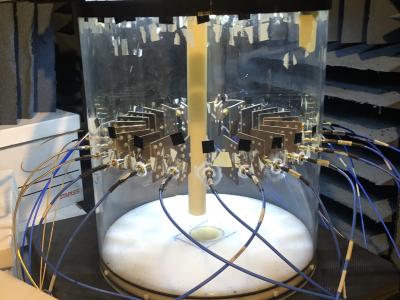Artificial Intelligence
The electroretinogram (ERG) is a clinical test that records the retina's electrical response to light. The ERG is a promising way to study different neurodevelopmental and neurodegenerative disorders, including Autism Spectrum Disorder (ASD) - a neurodevelopmental condition that impacts language, communication, and social interactions. However, privacy issues and a lack of data complicate Artificial Intelligence applications in this domain. Synthetic ERG signals generated from real ERG recordings should carry similar information and could be used as an extension for natural data.
- Categories:
 254 Views
254 ViewsWith the goal of improving machine learning approaches in inverse scattering, we provide an experimental data set collected with a 2D near-field microwave imaging system. Machine learning approaches often train solely on synthetic data, and one of the reasons for this is that no experimentally-derived public data set exists. The imaging system consists of 24 antennas surrounding the imaging region, connected via a switch to a vector network analyzer. The data set contains over 1000 full Scattering parameter scans of five targets at numerous positions from 3-5 GHz.
- Categories:
 481 Views
481 Views
The ACDC dataset contains short-axis cardiac magnetic resonance imaging (MRI) images which are obtained from 100 patients. For each image, segmentation labels are provided for the left ventricle (LV), myocardium (Myo), and right ventricle (RV). From these, 70, 10, and 20 patient cases are randomly selected as the training, validation, and test sets, respectively.
- Categories:
 183 Views
183 Views
DJI 4 Pro UAV with a wheelbase of 350 mm, camera pixels of 20 million pixels, image sensor of 1 inch CMOS, lens parameters of FOV 84°, 8.8 mm / 24 mm (35 mm format equivalent), and aperture of f/2.8-f/11. Equipped with GPS/GLONASS dual mode positioning, the captured image resolution is 5472 pixelsÍ3078 pixels, and the aspect ratio is 16:9. The flight adopts the route automatically planned by the DJI UAV, and the aerial photography is completed and landed with automatic return.
- Categories:
 26 Views
26 Views
This is the dataset of the paper: A Non-Invasive Circuit Breaker Arc Duration Measurement Method with Improved Robustness Based on Vibration–Sound Fusion and Convolutional Neural Network (https://doi.org/10.3390/en16186551). Here is the abstract of the paper. Previous studies have shown that the contact wear estimation of circuit breakers can be based on the accumulative arc duration. However, one problem that remains unresolved is how to reliably measure the arc duration.
- Categories:
 175 Views
175 Views
While it is well known that population differences from genetics, sex, race, and environmental factors contribute to disease, AI studies in medicine have largely focused on locoregional patient cohorts with less diverse data sources. Such limitation stems from barriers to large-scale data share and ethical concerns over data privacy. Federated learning (FL) is one potential pathway for AI development that enables learning across hospitals without data share.
- Categories:
 33 Views
33 Views
THERE was once an Emperor who had a horse shod with gold. He had a golden shoe on each foot, and why was this? He was a beautiful creature. He had slender legs, bright, intelligent eyes, and a mane that hung down over his neck like a veil.
- Categories:
 128 Views
128 Views
This data set is from the pictures collected at the industrial production site of the power adapter.The dataset contains surface defects such as scratches, glue spills, dirt, dirty spots, and off-frame labels that occur during the production process of the power adapter. The original dataset contains 235 images with a height and width of 2448 and 2048, which are annotated in VOC2007 format. These defects were categorized into five classes: label, mark, scratch, smudge, and spill, with each class containing 32, 38, 58, 80, and 32 images.
- Categories:
 50 Views
50 Views
An AI-based Ancient Hebrew Language Translator aims to revive Ancient Hebrew by constructing a comprehensive dataset with contemporary and ancient Hebrew samples. Seamless integration of the Google Vision API facilitates Optical Character Recognition (OCR) for image processing. The translation process initiates in English through the model, leading to a multilingual interface. This initiative represents a crucial step in preserving ancient languages in the digital age.
- Categories:
 3 Views
3 Views

